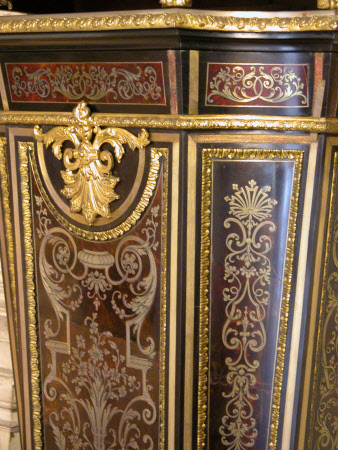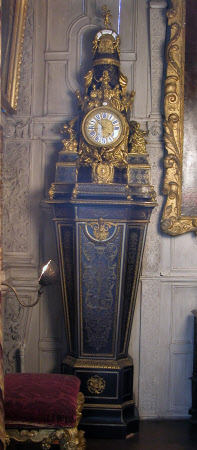Clock
Étienne Baillon (b.1678)
Category
Horology
Date
Unknown
Materials
Black and red turtle shell, ebony, gilt bronze mounts, brass and tin
Measurements
138.0 x 70.0 x 35.0 cm
Place of origin
Paris
Order this imageCollection
Knole, Kent
NT 129615
Summary
An imposing late Louis XIV Boulle marquetry clock, c.1710, on a later stand, c.1780 with a gilt bronze figure of Louis XIV surrounded by personifications of Fame and the Arts. The movement signed on an enamel oval within a gilt bronze sunflower ‘Etienne Baillon Paris’ for Étienne Baillon (Rouen, 1677-Paris, before 1748). Twin train 8 day movement with verge escapement driving silk-suspension pendulum. Striking through rear mounted rack. The pedestal incorporates Boulle marquetry, in a rather different taste, partly on a red ground (unlike the clock case), which suggests that the marriage between the clock and barometer with the pedestal was arranged later, possibly in the last years of the reign of Louis XVI. Indeed, this splendid creation was thought by the 1864 inventory taker at Knole to have been ‘presented to Lord Whitworth by Louis XVI’. The clock’s gilt bronze mounts – elaborate in design yet fairly crude in execution – are centred upon a youthful Louis XIV, who sits enthroned, flanked by two pairs of seated female figures, the pair below personifying Fame and the Arts. Above is an obelisk-shaped barometer, with white enamel plaques marked ‘PLUVIEUX’, ‘CHANGEANT’ and ‘BEAUTÉ’, the lower half in the form of a royal canopy, the upper part with the radiant Apollo mask of the Sun King flanked by putti. The clock was almost certainly acquired by Charles Whitworth, Earl Whitworth during his embassy in Paris, in the Spring of 1803. An invoice addressed to Whitworth by Jacob Frères lists ‘Une Grande Pendule de boule don’t les bronzes réprésentent Louis 14… 900 fr’ [A large Boulle clock of which the bronzes depict Louis XIV… 900 francs] (Kent History and Library Centre, Maidstone, KHLC, U269/O211). The clock was packed up by the Parisian marchand-mercier Martin-Eloi Lignereux and shipped to England in four separate, numbered crates, which were among more than 200 packages that constituted Whitworth’s household goods: no. 86 the clock proper, no. 89 the base, no. 190 a little gilt-bronze putto, and no. 191 the clock’s barometer – with other items in those crates (KHLC, U269/O210).
Full description
This most imposing clock is a late Louis XIV Boulle pendule, c.1710, on a later stand, c.1780. The movement signed on an enamel oval within a gilt bronze sunflower ‘Etienne Baillon Paris’ for Étienne Baillon (Rouen, 1677-Paris, before 1748). The pedestal incorporates Boulle marquetry, in a rather different taste, partly on a red ground (unlike the clock case), which suggests that the marriage between the clock and barometer with the pedestal was arranged later, possibly in the last years of the reign of Louis XVI. Indeed, this splendid creation was thought by the 1864 inventory taker at Knole to have been ‘presented to Lord Whitworth by Louis XVI’. The clock’s gilt bronze mounts – elaborate in design yet fairly crude in execution – are centred upon a youthful Louis XIV, who sits enthroned, flanked by two pairs of seated female figures, the pair below personifying Fame and the Arts. Above is an obelisk-shaped barometer, with white enamel plaques marked ‘PLUVIEUX’, ‘CHANGEANT’ and ‘BEAUTÉ’, the lower half in the form of a royal canopy, the upper part with the radiant Apollo mask of the Sun King flanked by putti. The clock was almost certainly acquired by Charles Whitworth, Earl Whitworth during his embassy to Paris, during the fragile Peace of Amiens between 1802 and 1803. An invoice addressed to Whitworth by Jacob Frères lists ‘Une Grande Pendule de boule don’t les bronzes réprésentent Louis 14… 900 fr’ [A large Boulle clock of which the bronzes depict Louis XIV… 900 francs] (Kent History and Library Centre, Maidstone, KHLC, U269/O211). Like the 3rd Duke of Dorset, Lord Whitworth leased the Hôtel de Charost, which had previously belonged to Napoleon’s sister Princess Pauline Borghese and, in 1814, would be acquired by the Duke of Wellington, who made it the first permanent British embassy. At the conclusion of the fragile Peace of Amiens between Britain and France, Martin-Eloi Lignereux packed up part of Lord Whitworth’s belongings. He undertook the packing in tandem with François Benois, employed from 1804 by the Prince of Wales (the future George IV), as a confectioner and occasional adviser on acquisitions of works of art. Such as the scale of the operation – there were 234 crates (some belonging to Whitworth’s household and friends) – that Lignereux alone charged 6,390 livres for packing and materials. After being packed up by Lignereux in four separate, numbered crates, the clock was shipped to England among more than 200 packages that constituted Whitworth’s household goods: no. 86 the clock proper, no. 89 the base, no. 190 a little gilt-bronze putto, and no. 191 the clock’s barometer – with other items in those crates (KHLC, U269/O210; the full packing list was published by Christopher Rowell and Wolf Burchard in Furniture History LII (2016), pp. 181-213). On 1 June 1803, Lignereux wrote to Whitworth, who had left Paris for London on 12 May, confirming that ‘la Totalité de tout votre mobilier, c’est à dire ce dont j’ai été chargé de faire l’embalage [sic], partira de Paris samedi prochain, 4 Juin’ [the totality of your furniture, that is those pieces, which I was commissioned to pack, will leave Paris next Saturday, 4 June]. Crates nos 89, 190 and 191, contacting the disassembled base, barometer and cresting respectively of the Boulle clock, left Calais on 14 July 1803 together with 76 other crates, all marked ‘LW’, on the ‘Yonge Florens’ under Captain Johan Devries. No. 86, the actual clock, had travelled with thirty-two other crates and three suitcases on a French boat, ‘La Parfaite Union’, captained by Jean Mascot, which left Calais for Dover much earlier, on 19 June 1803. A set of invoices for containers to be brought from Dover to Knole shows that crates 89, 190 and 191 were signed off on 8 August 1803 by a certain Mr Rutley, representing the firm Self & Stanbury, ‘to be conveyed to Knole in the County of Kent and there deliver’d to the Right Hon.ble Lord Whitworth’ (Rowell and Burchard 2016a, p. 191-2).
Provenance
Supplied by Jacob Frères, Paris, Charles, Lord Whitworth, second husband of Arabella, Duchess of Dorset, during his embassy in Paris in the spring of 1803 and moved to Knole in the summer. Knole and the majority of its furniture were accepted by HM Treasury in part payment of death duties and transferred to the National Trust in 1946.
Makers and roles
Étienne Baillon (b.1678), maker
References
Rowell and Burchard 2016a: Christopher Rowell and Wolf Burchard, 'From Knole to Paris: The third Duke of Dorset and the first Earl Whitworth as diplomatic Patrons and Collectors', National Trust Historic Houses & Collections Annual/Apollo (2016): 43-52. Rowell and Burchard 2016b: C. Rowell and W. Burchard, ‘François Benois, Martin-Eloi Lignereux and Lord Whitworth: Leasing, Furnishing and Dismantling the British Embassy in Paris during the Peace of Amiens, 1802-03’, Furniture History LII (2016): 181-213



